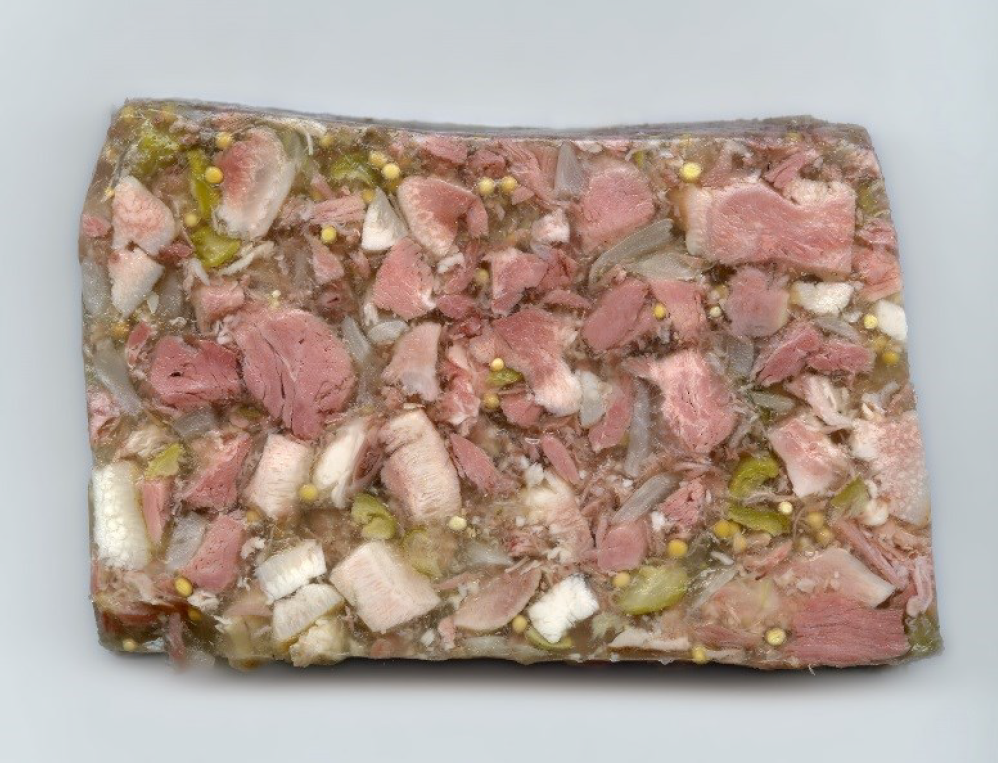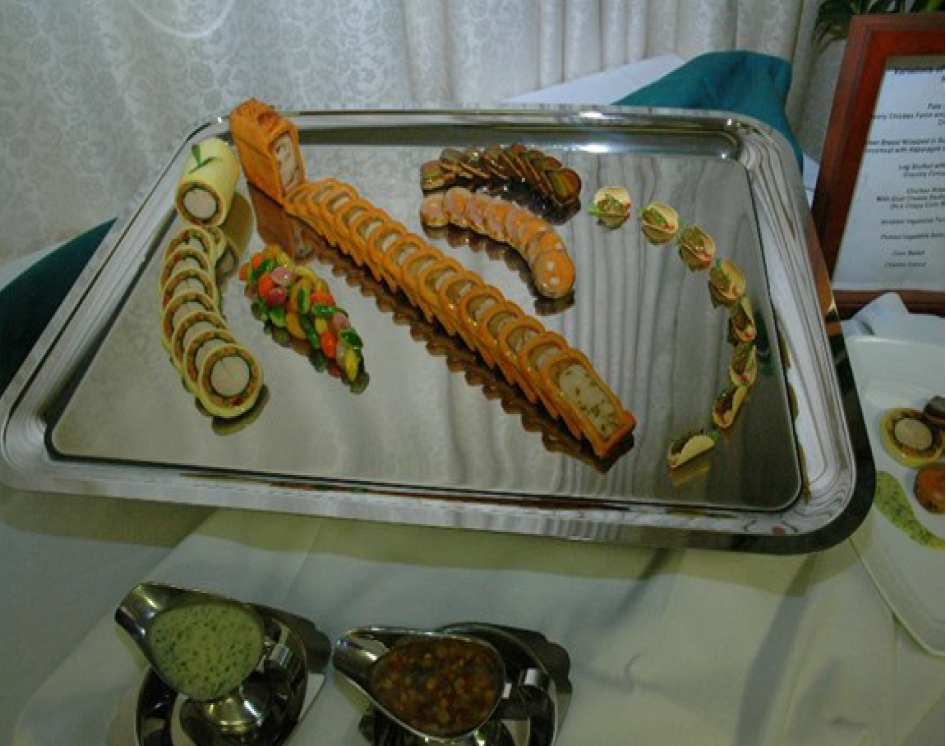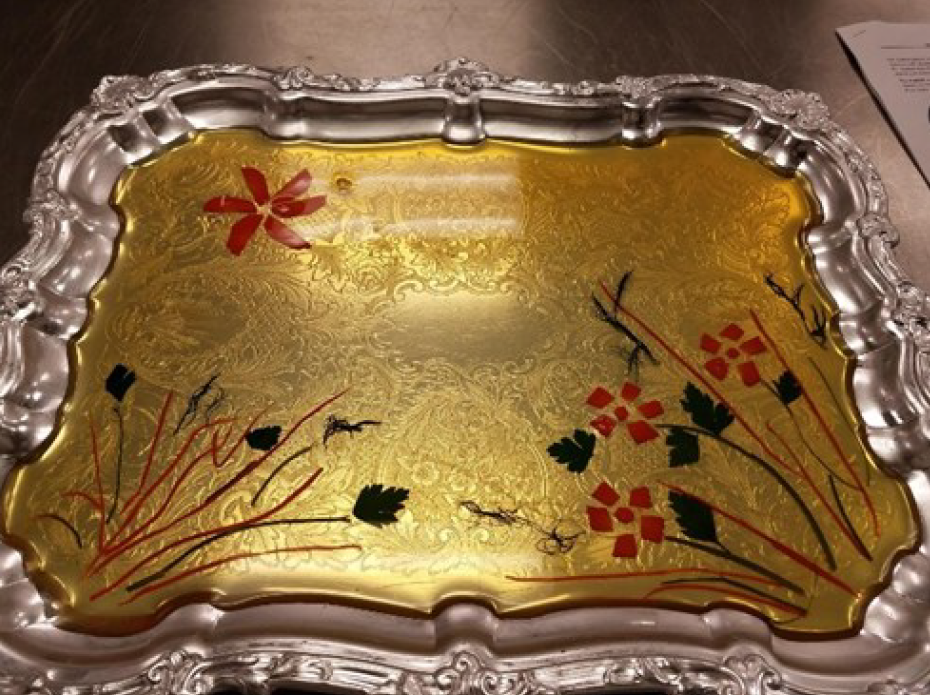1.10: Aspic and Cold Platter Creation
- Page ID
- 23633
\( \newcommand{\vecs}[1]{\overset { \scriptstyle \rightharpoonup} {\mathbf{#1}} } \)
\( \newcommand{\vecd}[1]{\overset{-\!-\!\rightharpoonup}{\vphantom{a}\smash {#1}}} \)
\( \newcommand{\id}{\mathrm{id}}\) \( \newcommand{\Span}{\mathrm{span}}\)
( \newcommand{\kernel}{\mathrm{null}\,}\) \( \newcommand{\range}{\mathrm{range}\,}\)
\( \newcommand{\RealPart}{\mathrm{Re}}\) \( \newcommand{\ImaginaryPart}{\mathrm{Im}}\)
\( \newcommand{\Argument}{\mathrm{Arg}}\) \( \newcommand{\norm}[1]{\| #1 \|}\)
\( \newcommand{\inner}[2]{\langle #1, #2 \rangle}\)
\( \newcommand{\Span}{\mathrm{span}}\)
\( \newcommand{\id}{\mathrm{id}}\)
\( \newcommand{\Span}{\mathrm{span}}\)
\( \newcommand{\kernel}{\mathrm{null}\,}\)
\( \newcommand{\range}{\mathrm{range}\,}\)
\( \newcommand{\RealPart}{\mathrm{Re}}\)
\( \newcommand{\ImaginaryPart}{\mathrm{Im}}\)
\( \newcommand{\Argument}{\mathrm{Arg}}\)
\( \newcommand{\norm}[1]{\| #1 \|}\)
\( \newcommand{\inner}[2]{\langle #1, #2 \rangle}\)
\( \newcommand{\Span}{\mathrm{span}}\) \( \newcommand{\AA}{\unicode[.8,0]{x212B}}\)
\( \newcommand{\vectorA}[1]{\vec{#1}} % arrow\)
\( \newcommand{\vectorAt}[1]{\vec{\text{#1}}} % arrow\)
\( \newcommand{\vectorB}[1]{\overset { \scriptstyle \rightharpoonup} {\mathbf{#1}} } \)
\( \newcommand{\vectorC}[1]{\textbf{#1}} \)
\( \newcommand{\vectorD}[1]{\overrightarrow{#1}} \)
\( \newcommand{\vectorDt}[1]{\overrightarrow{\text{#1}}} \)
\( \newcommand{\vectE}[1]{\overset{-\!-\!\rightharpoonup}{\vphantom{a}\smash{\mathbf {#1}}}} \)
\( \newcommand{\vecs}[1]{\overset { \scriptstyle \rightharpoonup} {\mathbf{#1}} } \)
\( \newcommand{\vecd}[1]{\overset{-\!-\!\rightharpoonup}{\vphantom{a}\smash {#1}}} \)
\(\newcommand{\avec}{\mathbf a}\) \(\newcommand{\bvec}{\mathbf b}\) \(\newcommand{\cvec}{\mathbf c}\) \(\newcommand{\dvec}{\mathbf d}\) \(\newcommand{\dtil}{\widetilde{\mathbf d}}\) \(\newcommand{\evec}{\mathbf e}\) \(\newcommand{\fvec}{\mathbf f}\) \(\newcommand{\nvec}{\mathbf n}\) \(\newcommand{\pvec}{\mathbf p}\) \(\newcommand{\qvec}{\mathbf q}\) \(\newcommand{\svec}{\mathbf s}\) \(\newcommand{\tvec}{\mathbf t}\) \(\newcommand{\uvec}{\mathbf u}\) \(\newcommand{\vvec}{\mathbf v}\) \(\newcommand{\wvec}{\mathbf w}\) \(\newcommand{\xvec}{\mathbf x}\) \(\newcommand{\yvec}{\mathbf y}\) \(\newcommand{\zvec}{\mathbf z}\) \(\newcommand{\rvec}{\mathbf r}\) \(\newcommand{\mvec}{\mathbf m}\) \(\newcommand{\zerovec}{\mathbf 0}\) \(\newcommand{\onevec}{\mathbf 1}\) \(\newcommand{\real}{\mathbb R}\) \(\newcommand{\twovec}[2]{\left[\begin{array}{r}#1 \\ #2 \end{array}\right]}\) \(\newcommand{\ctwovec}[2]{\left[\begin{array}{c}#1 \\ #2 \end{array}\right]}\) \(\newcommand{\threevec}[3]{\left[\begin{array}{r}#1 \\ #2 \\ #3 \end{array}\right]}\) \(\newcommand{\cthreevec}[3]{\left[\begin{array}{c}#1 \\ #2 \\ #3 \end{array}\right]}\) \(\newcommand{\fourvec}[4]{\left[\begin{array}{r}#1 \\ #2 \\ #3 \\ #4 \end{array}\right]}\) \(\newcommand{\cfourvec}[4]{\left[\begin{array}{c}#1 \\ #2 \\ #3 \\ #4 \end{array}\right]}\) \(\newcommand{\fivevec}[5]{\left[\begin{array}{r}#1 \\ #2 \\ #3 \\ #4 \\ #5 \\ \end{array}\right]}\) \(\newcommand{\cfivevec}[5]{\left[\begin{array}{c}#1 \\ #2 \\ #3 \\ #4 \\ #5 \\ \end{array}\right]}\) \(\newcommand{\mattwo}[4]{\left[\begin{array}{rr}#1 \amp #2 \\ #3 \amp #4 \\ \end{array}\right]}\) \(\newcommand{\laspan}[1]{\text{Span}\{#1\}}\) \(\newcommand{\bcal}{\cal B}\) \(\newcommand{\ccal}{\cal C}\) \(\newcommand{\scal}{\cal S}\) \(\newcommand{\wcal}{\cal W}\) \(\newcommand{\ecal}{\cal E}\) \(\newcommand{\coords}[2]{\left\{#1\right\}_{#2}}\) \(\newcommand{\gray}[1]{\color{gray}{#1}}\) \(\newcommand{\lgray}[1]{\color{lightgray}{#1}}\) \(\newcommand{\rank}{\operatorname{rank}}\) \(\newcommand{\row}{\text{Row}}\) \(\newcommand{\col}{\text{Col}}\) \(\renewcommand{\row}{\text{Row}}\) \(\newcommand{\nul}{\text{Nul}}\) \(\newcommand{\var}{\text{Var}}\) \(\newcommand{\corr}{\text{corr}}\) \(\newcommand{\len}[1]{\left|#1\right|}\) \(\newcommand{\bbar}{\overline{\bvec}}\) \(\newcommand{\bhat}{\widehat{\bvec}}\) \(\newcommand{\bperp}{\bvec^\perp}\) \(\newcommand{\xhat}{\widehat{\xvec}}\) \(\newcommand{\vhat}{\widehat{\vvec}}\) \(\newcommand{\uhat}{\widehat{\uvec}}\) \(\newcommand{\what}{\widehat{\wvec}}\) \(\newcommand{\Sighat}{\widehat{\Sigma}}\) \(\newcommand{\lt}{<}\) \(\newcommand{\gt}{>}\) \(\newcommand{\amp}{&}\) \(\definecolor{fillinmathshade}{gray}{0.9}\)Historically, meat aspics were made before fruit- and vegetable-flavored aspics or 'jellies' (UK) and 'gelatins' (North America). By the middle Ages at the latest, cooks had discovered that a thickened meat broth could be made into a jelly. A detailed recipe for aspic is found in Le Viandier, written in or around 1375.
In the early 19th century, Marie-Antoine Carême created chaud froid in France. Chaud froid means "hot cold" in French, referring to foods that were prepared hot and served cold. Aspic was used as a chaud froid sauce in many cold fish and poultry meals. The sauce added moisture and flavor to the food. Carême invented various types of aspic and ways of preparing it. Aspic, when used to hold meats, prevents them from becoming spoiled. The gelatin keeps out air and bacteria, keeping the cooked meat fresh.
Aspic came into prominence in America in the early 20th century. By the 1950s, meat aspic was a popular dinner staple throughout the United States as were other gelatin-based dishes such as tomato aspic. Cooks show off aesthetic skills by creating inventive aspics.
Uses
Aspic can also be referred as aspic gelée or aspic jelly. Aspic jelly may be colorless (white aspic) or contain various shades of amber. Aspic can be used to protect food from the air, to give food more flavor, or as a decoration.
There are three types of aspic: delicate, sliceable, and inedible. The delicate aspic is soft. The sliceable aspic must be made in a terrine or in an aspic mold. It is firmer than the delicate aspic. The inedible aspic is never for consumption. It is usually for decoration. Aspic is often used to glaze food pieces in food competitions to make the food glisten and make it more appealing to the eye. Foods dipped in aspic have a lacquered finish for a fancy presentation. Aspic can be cut into various shapes and be used as a garnish for deli meats or pâtés.
Aspics were once more popular than as of late. Developed by the early Grade Manger in France for the purpose of creating a “chemise” or shirt- a coating for the lead platters and used to coat terrines, pates, and galantines, these aspics served as a flavorful gel turning to a sauce in one’s warm mouth. Aspics added flavor and protected the product from drying. During WWII in America, aspics were popularized because of rationing and the need to support the war effort. Thus, tomato aspics were a part of the menu when proteins were in short supply.
Coating sauces and Chaud-froids are the primary concerns of our discussion regarding cold platter creation. Aspics are made by adding gelatin to a flavorful stock while Chaud-froids are made by adding gelatin to warm sauces like béchamel, demi-glace, and veloute.
Aspics rely on stocks that are clarified as you would a consommé to avoid cloudiness. The addition of gelatin based on the required strength for the task at hand is done while the stock is warm. It is then cooled over an ice bath to reveal a thickened state. If allowed to set cold it can be used itself as a garnish or later warmed to coat a serving platter or cold pate.

Aspic used to bind Headcheese- commons.wikimedia.org

The galantine on the left above is coated in Chaud-froid; the terrine in the center is En Croute - Commons.wikimedia.org
Aspic Ratio Concentrations
- 2oz. per gallon for delicate coating
- 4 oz. per gallon for edible Chaud Froid
- 8 oz. per gallon for sliceable/moldable
- 12 oz. per gallon / tough non-edible (i.e. Chaud Froid platter)
Once the terrine or galantine is made, it can be divided with equally sized slices as illustrated in the photos. The slices are coated in aspic and a portion of the terrine is reserved to be the “grosse piece”. The grosse piece is the focal point of the platter and is coated likewise in aspic. The coated slices are arranged from the edge of the grosse piece, and shingled over each other. The purpose is to convey movement, and draw the eye to the centerpiece or focal point. Of course, the platter should have some decorative aspect under the aspic. This is achieved by brushing aspic on the platter, attaching garnish, and covering with slightly tempered aspic on a level and cold platter. Allow the gel to strengthen before placing the grosse piece and slices.

A decorated platter with chemise by a student at CJFCI
Working with gelatin
Bloom powdered gelatin in cool water first then warm it to dissolve the granules before adding to the stock. Refer to the power point in the LMS (Moodle®) for more do’s and don’ts about gelatin.
Aspic and Cold Platter Creation
- Aspics add _____________ and protect terrine items from ______________________.
- It is best to clarify a stock as you would a ________________________ before making the aspic.
- What are the following ratios for gelatin to one gallon of stock or chaud froid?
- Delicate coating _________________. Edible Chaud Froid ________________.
- Sliceable/ moldable gelatin _____________. Durable non-edible ______________.
- True or False. Circle one. The first step when working with gelatin is to bloom it in cool water.
- Do you need to warm the bloomed gelatin to dissolve the granules?
- What animal materials are used to create gelatin
- Name three other form of gelatin.
- List the five cardinal rules for aspic.
- What is the base sauce for Chaud Froid?
- Give three examples of natural coloring for Chaud Froid.


